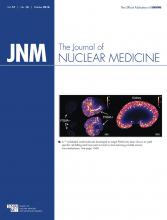Abstract
A PET tracer is desired to help guide the discovery and development of disease-modifying therapeutics for neurodegenerative diseases characterized by neurofibrillary tangles (NFTs), the predominant tau pathology in Alzheimer disease (AD). We describe the preclinical characterization of the NFT PET tracer 18F-MK-6240. Methods: In vitro binding studies were conducted with 3H-MK-6240 in tissue slices and homogenates from cognitively normal and AD human brain donors to evaluate tracer affinity and selectivity for NFTs. Immunohistochemistry for phosphorylated tau was performed on human brain slices for comparison with 3H-MK-6240 binding patterns on adjacent brain slices. PET studies were performed with 18F-MK-6240 in monkeys to evaluate tracer kinetics and distribution in the brain. 18F-MK-6240 monkey PET studies were conducted after dosing with unlabeled MK-6240 to evaluate tracer binding selectivity in vivo. Results: The 3H-MK-6240 binding pattern was consistent with the distribution of phosphorylated tau in human AD brain slices. 3H-MK-6240 bound with high affinity to human AD brain cortex homogenates containing abundant NFTs but bound poorly to amyloid plaque–rich, NFT-poor AD brain homogenates. 3H-MK-6240 showed no displaceable binding in the subcortical regions of human AD brain slices and in the hippocampus/entorhinal cortex of non-AD human brain homogenates. In monkey PET studies, 18F-MK-6240 displayed rapid and homogeneous distribution in the brain. The 18F-MK-6240 volume of distribution stabilized rapidly, indicating favorable tracer kinetics. No displaceable binding was observed in self-block studies in rhesus monkeys, which do not natively express NFTs. Moderate defluorination was observed as skull uptake. Conclusion: 18F-MK-6240 is a promising PET tracer for the in vivo quantification of NFTs in AD patients.
Footnotes
Published online May 26, 2016.
- © 2016 by the Society of Nuclear Medicine and Molecular Imaging, Inc.







